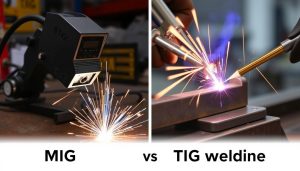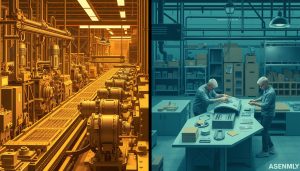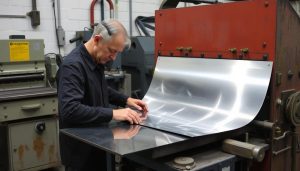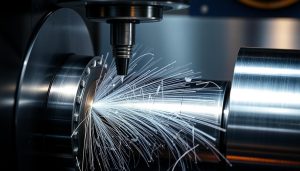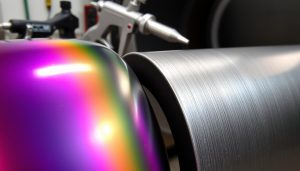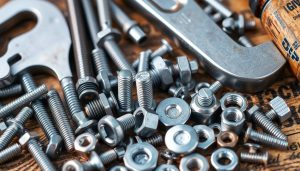In the rapidly evolving world of precision metal fabrication, the use of advanced steel cutting technology has become a game-changer. Laser cutting, a revolutionary process, has emerged as a highly efficient and precise method for shaping and crafting steel components. This article explores the remarkable advantages and cutting-edge techniques that make laser cutting steel an essential tool for industries across the globe.
What is Laser Cutting?
Laser cutting is a highly precise and efficient technology used to cut a wide range of materials, including steel. This process employs a focused, high-energy laser beam to melt or vaporize the target material along a predetermined path, creating intricate and accurate cuts. The laser beam’s intense heat allows for clean, smooth cuts with minimal material waste, making it a popular choice for various industrial and manufacturing applications.
Overview of the Laser Cutting Process
The laser cutting process typically involves the following steps:
- The laser source, such as a CO2 laser or fiber laser, generates a high-energy beam.
- The laser beam is focused and directed onto the surface of the steel workpiece using a series of mirrors and lenses.
- As the laser beam interacts with the steel, it melts or vaporizes the material along the desired cutting path.
- An assist gas, such as oxygen or nitrogen, is often used to facilitate the cutting process and remove the molten material.
- The cutting head or the workpiece is precisely moved to create the desired cut pattern.
How Laser Cutting Works for Steel
Steel, being a dense and durable material, requires a powerful laser source to effectively cut through it. The high-intensity laser beam rapidly heats the steel, causing it to melt and vaporize. The assist gas helps to eject the molten material, leaving a clean and precise cut. The speed and accuracy of the laser cutting process make it an attractive choice for cutting steel parts, especially when compared to traditional methods like plasma cutting or mechanical sawing.
Types of Lasers Used in Steel Cutting
The two most common types of lasers used in steel cutting are CO2 lasers and fiber lasers. Each type has its own unique characteristics and advantages:
- CO2 Lasers are known for their high power output, making them well-suited for cutting thicker steel materials.
- Fiber Lasers offer higher energy efficiency, smaller size, and easier maintenance, making them a popular choice for cutting thin to medium-thickness steel.
The choice between CO2 lasers and fiber lasers for steel cutting often depends on the specific requirements of the project, such as the thickness of the steel, the desired cutting speed, and the overall cost-effectiveness of the process.
Benefits of Laser Cutting Steel
When it comes to precise steel fabrication, laser cutting stands out as a superior technology, offering numerous advantages over traditional cutting methods. From its unparalleled accuracy to its remarkable efficiency, laser cutting is transforming the way manufacturers approach steel processing.
High Precision and Accuracy
The laser cutting process is renowned for its exceptional precision, allowing for the creation of intricate designs and complex geometries with precise steel fabrication. The narrow, focused beam of a laser enables cutting with remarkable accuracy, ensuring that each component is cut to the exact specifications required.
Speed and Efficiency in Steel Cutting
Laser cutting is a highly efficient metal cutting solution, delivering rapid turnaround times and increased productivity. The speed at which a laser can cut through steel is unmatched, making it an ideal choice for high-volume or time-sensitive projects.
Minimal Material Waste with Laser Technology
One of the key benefits of laser cutting steel is its ability to minimize material waste. The precision of the laser ensures that reduced material waste is generated during the cutting process, leading to cost savings and a more sustainable approach to steel fabrication.
“Laser cutting technology has revolutionized the steel fabrication industry, offering unparalleled precision, speed, and efficiency.”
By harnessing the power of laser technology, manufacturers can achieve a level of precise steel fabrication, efficient metal cutting, and reduced material waste that was once unimaginable. As the industry continues to evolve, laser cutting is set to play an increasingly vital role in the future of steel processing.
Applications of Laser Cutting Steel
The versatility of industrial laser cutting has made it an indispensable tool across a diverse range of industries. From the sleek designs of the automotive sector to the intricate components of aerospace engineering, laser cutting has revolutionized the way steel alloys are fabricated and transformed.
Common Industries That Use Laser Cutting for Steel
Laser cutting is widely utilized in the following industries:
- Automotive manufacturing: Cutting intricate body panels, structural components, and customized parts with unparalleled precision.
- Aerospace engineering: Fabricating complex airframe structures, engine components, and specialized steel fabrication for the aviation industry.
- Construction and architecture: Shaping steel beams, plates, and facades to create visually stunning and structurally sound buildings.
- Machinery and equipment manufacturing: Producing custom-made parts, brackets, and housings for industrial machinery.
Types of Steel Suitable for Laser Cutting
Laser cutting technology can handle a wide range of steel alloys, including:
- Carbon steel: Commonly used in construction, automotive, and general engineering applications.
- Stainless steel: Ideal for food processing equipment, medical devices, and marine applications due to its corrosion resistance.
- Alloy steel: Offering enhanced strength, hardness, and temperature resistance for demanding industries like aerospace and defense.
Challenges in Cutting Different Steel Types
While industrial laser cutting is a highly versatile technology, cutting different types of steel can present unique challenges. Factors such as material thickness, composition, and surface finish can impact the cutting quality, speed, and efficiency. Specialized expertise and state-of-the-art laser cutting equipment are often required to overcome these challenges and deliver consistently high-quality results.

“Laser cutting has revolutionized the way we approach steel fabrication, allowing us to create complex, high-precision parts with unparalleled efficiency.”
– Industry Expert, XYZ Manufacturing
Cost Factors in Laser Cutting Steel
When it comes to laser cutting steel, understanding the cost factors involved is crucial for businesses looking to maximize their return on investment (ROI). From the initial setup to the ongoing operational expenses, laser cutting technology presents a compelling value proposition that can elevate your steel fabrication processes.
Laser Cutting Setup and Operational Costs
The setup costs for laser cutting equipment can be significant, but the long-term benefits often outweigh the initial investment. Factors such as the type of laser, the power output, and the size of the cutting area can all influence the upfront cost. However, the operational expenses, including maintenance, energy consumption, and labor, are generally lower compared to traditional steel cutting methods.
Comparing Laser Cutting Costs to Other Methods
When evaluating the overall cost-effectiveness of laser cutting steel, it’s essential to consider the advantages it offers over other cutting techniques. Compared to plasma cutting or mechanical shearing, laser cutting can provide higher precision, faster turnaround times, and significantly less material waste, ultimately leading to a more cost-effective steel fabrication process.
Additionally, the metal cutting ROI achieved through laser cutting can be substantial, as the improved efficiency and quality of the final products can translate to increased customer satisfaction and repeat business.

“Investing in laser cutting equipment may have a higher initial cost, but the long-term benefits in terms of productivity, precision, and material savings make it a smart choice for many steel fabrication businesses.”
By carefully evaluating the cost factors associated with laser cutting steel, companies can make informed decisions that align with their operational goals and budgets, ultimately driving greater success in their steel fabrication projects.
Choosing Laser Cutting for Your Steel Fabrication Project
When it comes to steel fabrication, choosing the right cutting method can make all the difference in the quality, efficiency, and cost-effectiveness of your project. Laser cutting stands out as a premier choice, offering unparalleled precision, speed, and material savings. But how do you know if laser cutting is the best fit for your specific steel fabrication needs?
When to Use Laser Cutting for Steel
Laser cutting is particularly well-suited for projects that require intricate designs, tight tolerances, and minimal waste. If your steel fabrication involves complex shapes, delicate features, or the need for consistent, high-quality cuts, laser cutting is likely the optimal solution. It’s also an excellent choice for low-to-medium volume production runs, where the setup time and cost-effectiveness of laser technology can be fully leveraged.
Choosing the Right Laser Cutter for Your Needs
When selecting a laser cutting service provider, it’s essential to consider the specific requirements of your steel fabrication project. Factors like the thickness and type of steel, desired finish, and production volume will all influence the type of laser cutter that is best suited for your needs. Working with an experienced provider like Shixinproto, who offers a range of laser cutting capabilities, can help ensure you get the precise results you’re looking for.
Shixinproto’s Steel Laser Cutting Services
At Shixinproto, we take great pride in our ability to deliver exceptional laser cutting services for a wide range of steel fabrication projects. Our state-of-the-art equipment, skilled technicians, and commitment to quality make us the go-to choice for businesses seeking custom steel fabrication, precision metal prototyping, and more. Whether you’re looking to cut intricate patterns, achieve tight tolerances, or minimize material waste, Shixinproto has the expertise and resources to bring your steel fabrication vision to life.
